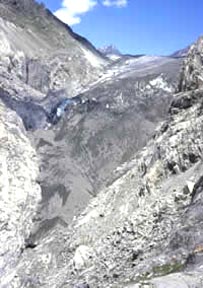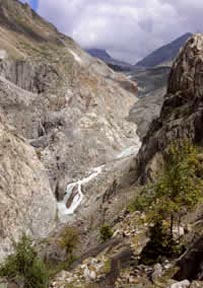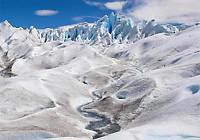

November 29, 2003 Milan, Italy – The World Wildlife Fund (WWF) released its new report this week about climate change and global glacier decline which headlines, “Unless governments take urgent action to prevent global warming, billions of people worldwide might face severe water shortages as a result of the alarming melt rate of glaciers.” Glaciers have contained 70% of the world’s freshwater reserves. But only a 4 degrees Celsius global temperature warming by the end of this 21st Century would “eliminate almost all of them.” Greenland ice sheets could be triggered to a complete melt-down with only a temperature increase of 2-3 degrees Celcius.
Current expectation for global warming temperature increase over the next 100 years: 1.4-5.8 degrees Celsius.

WWF sights examples of human dependence upon glacial ice:
- Ecuador, Peru and Bolivia are often the only water source for major cities during dry seasons.
- Himalaya Mountain rivers from glacial ice supply water to one-third of the world’s population.
- Island nations where sea level rise is already submerging lowlands and contaminating drinking water supplies with saltwater.
WWF sights examples of glacier retreats on all continents:
- Nearly all glaciers surveyed in Alaska are melting, thinning rates in the last 5 to 7 years are more than twice those seen in previous years.
- The northern Andes contain the largest concentration of glaciers in the tropics, but these glaciers are receding rapidly and losses have accelerated during the 1990s.
- Glacier melting has accelerated in the European Alps since 1980 and 10% to 20% of glacier ice in the Alps was lost in less than two decades.
WWF sights examples of animals at risk:
- Royal Bengal Tiger, an endangered species, will lose a large portion of their worldwide habitat as the Sundarbans land succumbs to sea level rise.
- Kittlitz’s Murrelet are rare birds specialized to hunt in cloudy glacier water and nest on top of ice.
- Coral Reefs vital to sea life are unique organisms that can be starved of energy from the sun when sea levels rise.
The Worldlife Fund is urging the governments of more than 180 countries attending the United Nations 9th Conference of the Parties (COP9) at the Framework Convention for Climate Change (UNFCCC) December 1-12 in Milan, Italy, to speed up action to combat climate change.
Jennifer Morgan, Director of WWF’s Climate Change Programme said, “Glacial meltdown is a clear signal that we must act now to fight global warming and stop the melting. COP9 must make it clear to the world that a multi-lateral approach to climate change is the only way forward, that Kyoto will soon enter into force and that international cooperation is well on track to tackle climate change.” But neither the United States nor Russia has ratified the Kyoto Protocol.
Website:
© 1998 - 2024 by Linda Moulton Howe.
All Rights Reserved.

